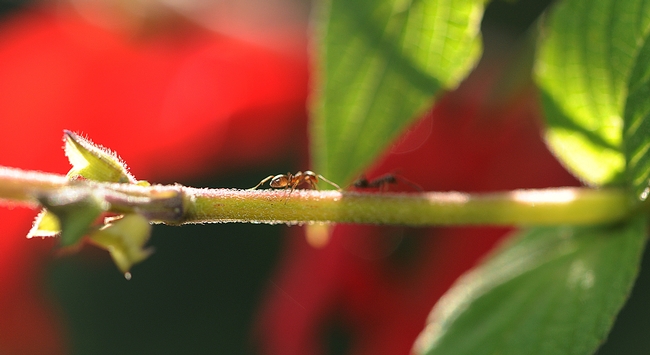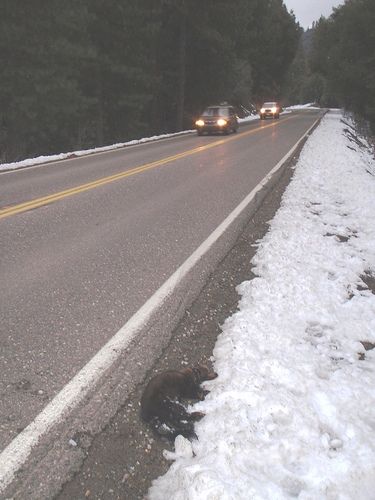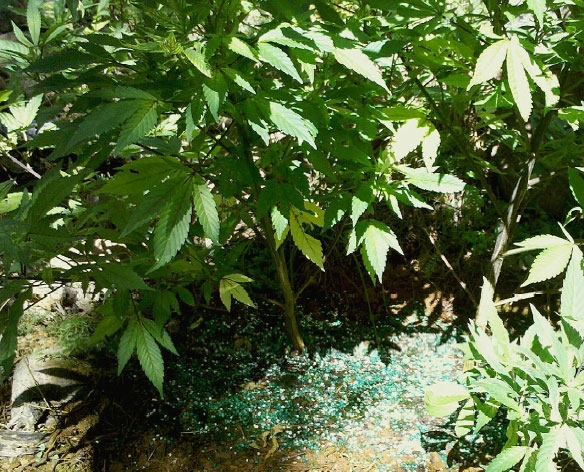Posts Tagged: fisher
Roadkill is a serious threat to rare wildlife populations
Why shouldn’t the chicken cross the road? Because statistics show it is very likely she will be run over! According to the Humane Society of the United States, over a million animals die on our roads every day.
Wildlife statistics gathered by the California Roadkill Observation System created by the Road Ecology Center at UC Davis have recorded almost 22,000 animal deaths on California roads in the last four years. Roads are an additional danger beyond those that Mother Nature already has in store for the wildlife of our state and it is one we bear the responsibility for. The loss of each animal affects its population numbers, it reproductive capacity and any babies left behind in its nests. But if an animal does not cross roads, it can result in genetic isolation in wildlife populations and loss of habitat.
For the Pacific fisher research team of the Sierra Nevada Adaptive Management Project (SNAMP), roadkill is very much a concern. They have been tracking the Pacific fisher, a nocturnal forest dwelling weasel, in the southern Sierra for the last five years. Their goal has been to identify the effects that forest thinning in may have on the fisher. In their careful tracking, they have recorded the deaths of nine of these rare animals on Highway 41, which cuts through the study area on its way to Yosemite. This is an important number considering the isolated population is estimated to be only about 300 individuals south of the Merced River; and these are only the roadkill incidents we know about.
In the team’s search for solutions to the roadkill issue, they have assembled a Wildlife-Vehicle Collision Group with the Forest Service, Yosemite National Park, Defenders of Wildlife and Caltrans to search for any possible solutions. Members of the SNAMP Wildlife Team put cameras in culverts passing beneath Highway 41 from Oakhurst to Yosemite to see if they were being used as a possible alternate route. (For details see the Sierra Nevada Highway Culvert Product, pdf). The good news is that many animals, including fisher, were found to be using road culverts to pass beneath the road, avoiding collisions with cars. This provides some hope that maintenance of the entrances and exits of existing culverts offers a safe alternative to road crossing for wildlife.
Perils of illegal marijuana crops
Rodenticides used on illegal marijuana farms have already been shown to pose serious harm to the fisher—a cat-sized carnivore found in forests across Canada and four regions in the U.S. (Previous news article.)
Mourad Gabriel, a doctoral candidate with the Veterinary Genetics Laboratory at UC Davis School of Veterinary Medicine, provides a more comprehensive look at the situation in the recent issue of The Wildlife Professional, put out by The Wildlife Society. (Article here.)
New information looks at risks to other species and to the ecologists and biologists conducting wildlife research on community and public lands where more of these crops are being cultivated.
Highlights include:
- Newly documented fisher mortalities (necropsies done at UC Davis’ California Animal Health and Food Safety Laboratory System)
- New data documenting just a glimpse of potential environmental degradation possibly occurring on our public lands
- First mention of toxicants like carbamates and organochlorides (DDT etc...) that are being found in California grow sites
- Provides readers with information on how some of these toxicants are placed at grow sites to maliciously poison wildlife
- New info and discussion points of "what are" the potential effects of ...such as damming water courses, putting toxic slurry of chemicals in dammed creeks, cutting riparian zones, human feces (affects salmon and many other species)
- First-hand accounts of ecologists and biologists conducting wildlife research being shot at, chased and threatened
- Quantifies the loss of project area access, and data from fisher projects in California public lands
There is also a link to a video that offers a first account visual representation of what a fisher looks like, the unfortunate visual effects of toxicosis and the realistic outcome to wildlife from these illicit activities on tribal and public lands.
For more information, contact Mourad Gabriel, mwgabriel@ucdavis.edu or Trina Wood, tjwood@ucdavis.edu
Evidence of rodenticide poisoning of wildlife found in the Sierra
There is a new predator in the forest these days. It has arisen quietly over the years. Any wildlife feeling hungry when they come upon it in the Sierra is vulnerable. This predator is amazingly small for the scope of its damage; it can’t run fast or climb high.
University of California scientists originally became aware of this problem when Rick Sweitzer, associate professor in the Department of Environmental Science, Policy and Management at UC Berkeley, and his wildlife research team retrieved a radio-collared fisher whose cause of death was unclear. Sweitzer and his team are researching are studying the fate Pacific fishers as part of the Sierra Nevada Adaptive Management Project (SNAMP).
Necropsy (an autopsy for animals) of the fisher carcass by Mourad Gabriel of UC Davis and the Integral Ecology Research Center found rodenticide poisoning to be the cause. With these new findings, the livers from previous fisher mortalities in the SNAMP study were reexamined for evidence of rodenticide exposure. They discovered that more than 80 percent of dead fishers examined had been exposed to rodenticide. These toxicants can persist in animal tissues or the environment for potentially hundreds of days. At least five dead fishers found by researchers in SNAMP and a second fisher study in northern California have been confirmed to have died of rodenticide poisoning, the scientists reported in the science journal PlusOne.
Considering the hundreds of marijuana grow sites found every year on public lands, the scale of the damage to California’s natural resources may be unprecedented. Grow sites are also found containing massive amounts of fertilizers, herbicides and pesticides, all of which are being used without concern for run off or aquatic species nearby. Marijuana plants are removed from these plots when found, but these chemicals are often left behind.
Although this problem might seem overwhelming, there are efforts to address it. The non-profit Environmental Reclamation Team has cleaned up hundreds of grow sites since 2005. They remove and document all of the poisons found along with the miles of plastic irrigation line and piles of trash. More efforts like this are needed if we are to maintain rare animals like the Pacific fisher as well as all the other species who have the potential of coming in contact with these poisons.
UC's 'viral' sock drive appears on the Bee's front page
Who would have thought old socks could drive a media storm? A call from participants in UC's Sierra Nevada Adaptive Management Project for donations of gently used socks for Pacific fisher research generated a flurry of response, and now the overwhelming public response resulted in a front-page story in the Sacramento Bee. The article also ran on the front page of the Fresno Bee.
Bee writer Matt Weiser reported that bulging padding envelopes and duct-taped boxes filled with socks trickled in at first. In time, boxes of socks from Girl Scout troops and elementary schools forced the researchers to wheel their mail from the post office in carts.
"We basically generated several truckloads," said UC Berkeley associate adjunct professor Rick Sweitzer. "It was incredible."
Sweitzer said Weiser had called him last week to ask about porcupines in California. Weiser said he and his wife had sent socks themselves last December. When he heard about the unexpected outpouring of socks, he turned his immediate attention to telling that story.
In Pursuit of Ants
Ants are such tiny critters. But they're much more than that. Much more. Ant specialist Brian Fisher, an entomologist with the California Academy...

Ants crawl along a vine. (Photo by Kathy Keatley Garvey)





